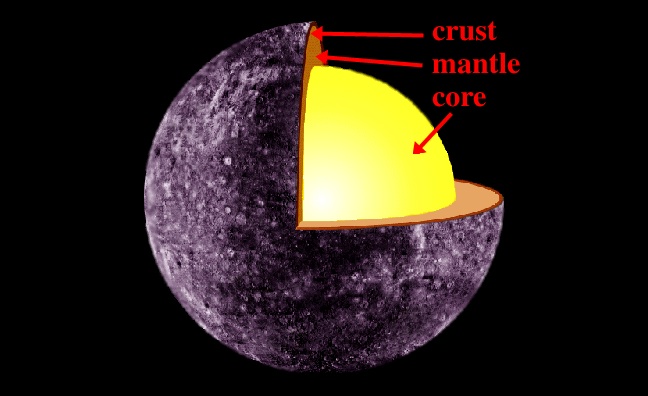Mercury is a terrestrial planet, like like all of the 4 inner planets: Mercury, Venus, Earth and Mars. It’s the smallest of them, and has a diameter of only 4,879 km at its equator. What is the composition of Mercury?
Astronomers have estimated that the Mercury composition is made up of approximately 70% metals and 30% silicate material. In fact, it’s only slightly less dense than the Earth, with 5.43 g/cm3.
Since Mercury is smaller than Earth, its gravity doesn’t compress it down as much, so it actually has much more heavier elements inside it. Geologists estimate that its core is very large, and mostly iron. The core probably accounts to 42% of Mercury’s volume, while Earth is just 17%.
The core itself is about 3,600 km across. Surrounding that is a 600 km thick mantle. And around that is the crust, which is believed to be 100-200 km thick. The crust is known to have narrow ridges that extend for hundreds of kilometers. Planetary scientists think that the ridges formed when the planet cooled and contracted underneath the crust, causing it to collapse down.
One reason to explain why Mercury has such a large core is that it was impacted by a large planetesimal early in its history. The impact would have stripped away much of the planet’s crust, leaving just the thick iron core. This is a similar process that explains the formation of the Moon. It’s also possible that Mercury formed before the Sun’s energy output settled down. If it had twice its original mass, the Sun could vaporize the surface of the planet, blasting it away with its power solar wind.
We have written many articles about Mercury for Universe Today. Here’s an article about the gravity on Mercury, and here’s an article about the color of Mercury
If you’d like more information on Mercury, check out NASA’s Solar System Exploration Guide, and here’s a link to NASA’s MESSENGER Misson Page.
We’ve also recorded an entire episode of Astronomy Cast all about Mercury. Listen here, Episode 49: Mercury.

